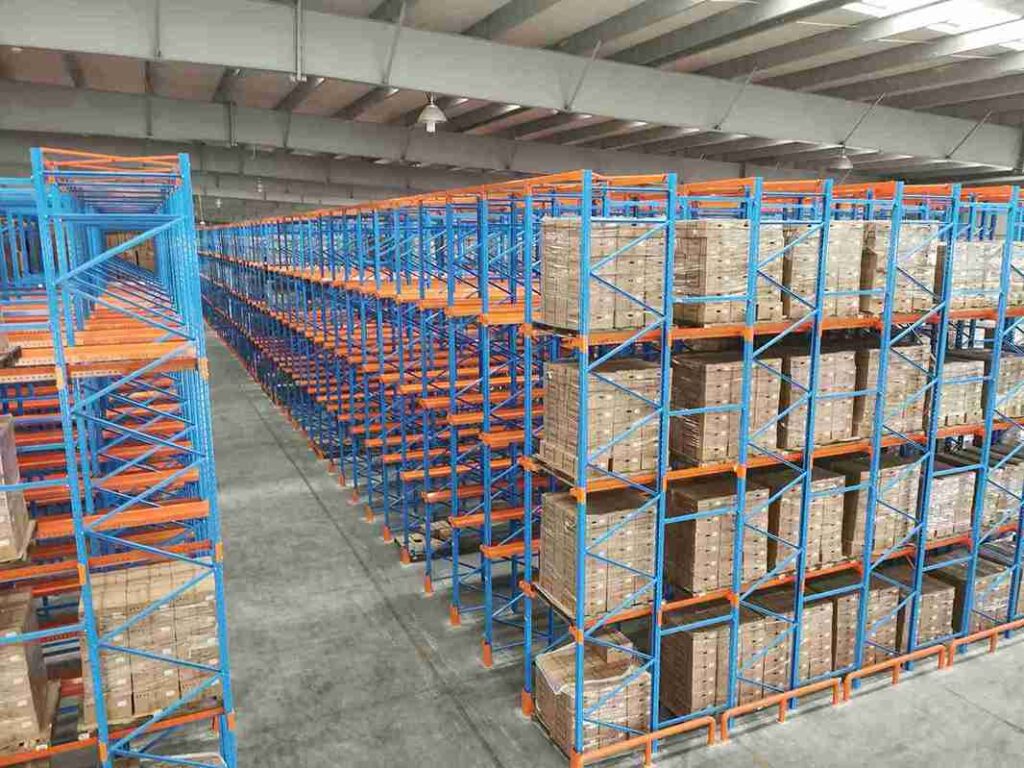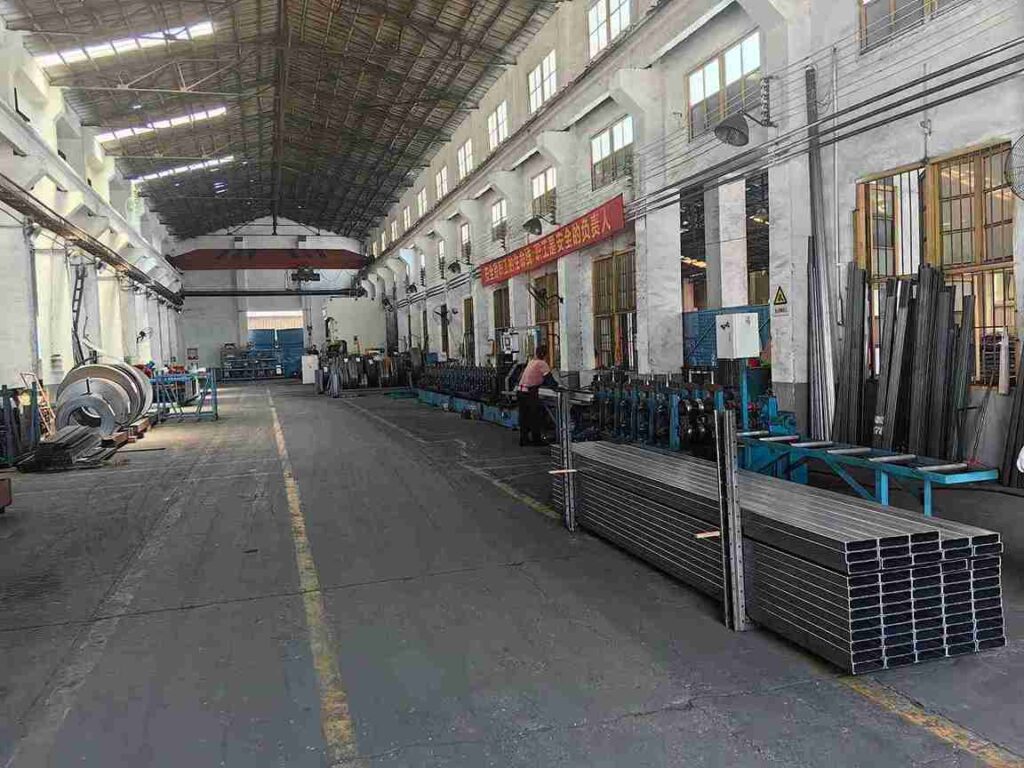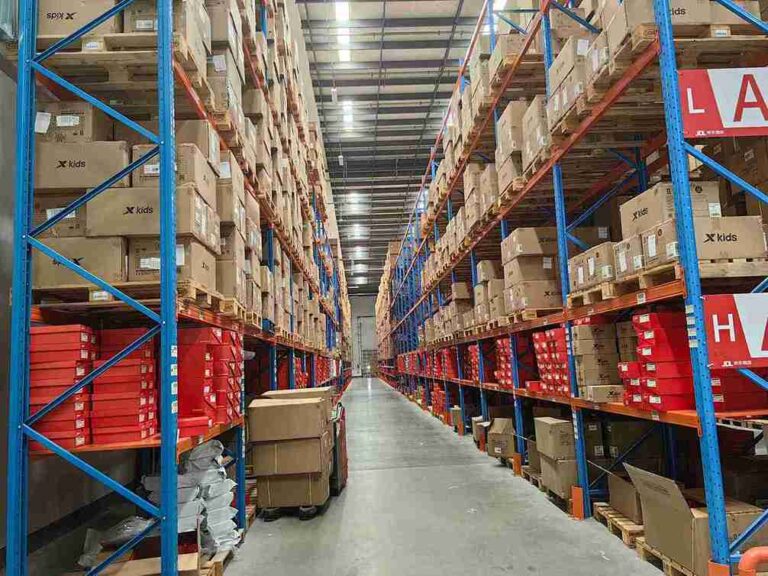📐 "First 50 Enterprise Queries Get Custom 3D Warehouse Design" Plan

Why the Narrow Aisle Racking vs Drive-In Cost Debate Matters
Every warehouse manager faces the same critical question: Which storage system delivers the best value—narrow aisle racking or drive-in racking? The narrow aisle racking vs drive-in cost decision impacts everything from upfront capital expenditure to long-term operational efficiency.
This comprehensive 7,500+ word guide provides an unbiased, data-driven comparison of these two systems, helping businesses determine which solution maximizes ROI, storage density, and labor productivity.

1. Breaking Down the Basics: What Are Narrow Aisle and Drive-In Racking?
1.1 Narrow Aisle Racking: High-Density Storage with Fast Access
Narrow aisle racking (NA racking) is engineered for space optimization without sacrificing accessibility. Unlike traditional wide-aisle setups, these systems operate in aisles as narrow as 1.5m, requiring specialized narrow aisle forklifts (NA trucks).
Key Advantages in the Narrow Aisle Racking vs Drive-In Cost Debate:
- Higher selectivity – Ideal for warehouses with high-SKU turnover
- Better space utilization than conventional racking (but less than drive-in)
- Faster order picking, reducing labor costs over time
1.2 Drive-In Racking: Maximum Pallet Density for Bulk Storage
Drive-in racking is the king of high-density storage, allowing forklifts to drive directly into the rack structure. It follows a Last-In, First-Out (LIFO) system, making it perfect for homogeneous, slow-moving inventory like beverages, paper goods, or frozen foods.
Why It’s a Contender in the Narrow Aisle Racking vs Drive-In Cost Battle:
- Unmatched pallet positions per square foot (up to 90% space utilization)
- Lower upfront racking costs compared to narrow aisle
- Works with standard forklifts, reducing equipment expenses

2. Narrow Aisle Racking vs Drive-In Cost: Upfront Investment Comparison
2.1 Racking Structure Costs
| Factor | Narrow Aisle Racking | Drive-In Racking |
|---|---|---|
| Material Costs | Higher (reinforced frames for stability) | Lower (simpler structural design) |
| Installation Complexity | Moderate (precision alignment needed) | High (requires reinforced flooring) |
| Aisle Space Savings | 30-50% better than wide-aisle | 60-70% better than selective racking |
Key Takeaway:
- Drive-in racking wins on initial structure costs but may need additional flooring reinforcement.
- Narrow aisle racking has higher upfront costs but delivers better accessibility and picking speed.
2.2 Forklift & Equipment Expenses
One of the biggest narrow aisle racking vs drive-in cost differentiators is equipment requirements:
- Narrow aisle systems demand specialized NA reach trucks (80,000 per unit).
- Drive-in systems work with standard counterbalance forklifts (50,000 per unit).
Operational Impact:
- NA trucks improve maneuverability but increase capital expenditure.
- Standard forklifts are cheaper but less efficient in high-turnover environments.

3. Long-Term Cost Analysis: Which System Saves More Over Time?
3.1 Storage Density & Warehouse Space Savings
When evaluating narrow aisle racking vs drive-in cost, storage density is a major deciding factor:
- Drive-in racking provides more pallet positions per sq. ft., reducing real estate costs.
- Narrow aisle racking offers better selectivity, cutting labor time in high-SKU operations.
Best Applications:
- Drive-in: Bulk storage (beverages, paper, cold storage).
- Narrow aisle: E-commerce, retail distribution, mixed-SKU warehouses.
3.2 Labor Efficiency & Hidden Operational Costs
- Narrow aisle systems allow 30% faster picking, reducing labor expenses.
- Drive-in systems require more time per retrieval due to LIFO access.
Cost Implication:
- Higher long-term labor costs with drive-in racking.
- Narrow aisle racking improves productivity, justifying its higher initial cost.
4. Narrow Aisle Racking vs Drive-In Cost: Which is Right for Your Business?
4.1 When to Choose Narrow Aisle Racking
✅ High-SKU environments (e-commerce, 3PLs)
✅ Fast-moving inventory needing quick access
✅ Limited floor space but high ceilings
4.2 When Drive-In Racking Makes More Financial Sense
✅ Bulk storage of identical products
✅ Slow-moving inventory (seasonal goods, raw materials)
✅ Maximizing pallet positions in a small footprint
5. Final Verdict: Which System Wins the Narrow Aisle Racking vs Drive-In Cost Battle?
The narrow aisle racking vs drive-in cost decision isn’t one-size-fits-all.
- Drive-in racking is cheaper upfront and excels in bulk storage.
- Narrow aisle racking reduces labor costs and boosts order-picking efficiency.
For high-turnover warehouses, narrow aisle often delivers better long-term ROI. For cold storage or bulk goods, drive-in racking may be the more economical choice.

Conclusion: The Final Verdict on Cost-Effectiveness
So, is Narrow Aisle or Drive-In Racking more cost-effective for your space? The definitive answer, born from 30 years of global projects, is: It depends entirely on your operational DNA.
If your primary goal is to store the maximum number of pallets of a limited number of SKUs in a relatively low-bay building, with medium-to-low throughput, and you have capital constraints, Drive-In Racking likely offers the better short to medium-term cost-effectiveness.
If your operation demands high throughput, excellent inventory control, adaptability, and a clear path to the future in a medium-to-high bay facility, the long-term total cost of ownership (TCO) of a Narrow Aisle system is almost always lower. The higher initial investment is a down payment on years of superior productivity, flexibility, and automation readiness.
The most cost-effective decision you can make today is not to guess. It is to conduct a detailed, data-driven analysis of your SKUs, throughput, growth projections, and facility specs. We provide this as a dedicated consultancy service—transforming the complex “narrow aisle racking vs drive-in cost” dilemma into a clear, confident investment roadmap for your warehouse’s future.
Frequently Asked Questions (FAQs)
1. How do seismic zone requirements (common in parts of Latin America and Asia) affect the cost comparison between NA and DIR?
Seismic certification significantly impacts both systems but differently. Drive-In racking, as a continuous block structure, requires extensive engineering to withstand lateral forces, often adding substantial material (steel) cost. Narrow Aisle racks, while also needing reinforcement, are individual frames that can be seismically rated and braced. The cost premium for seismic safety is significant for both, but can be proportionally higher for the dense, interconnected DIR block. Always consult with a local structural engineer and a racking supplier with proven seismic experience.
2. For a business with highly seasonal peaks (e.g., agricultural exporters), which system offers more operational flexibility to handle surge volumes?
Narrow Aisle systems typically handle surge better. During peak, you can add extra shifts or temporary operators (with training) to increase throughput linearly because each pick face remains accessible. In a Drive-In system, lanes can become congested or blocked during intense activity, creating bottlenecks that are hard to resolve quickly. The direct-access model of NA provides more predictable scalability during peak seasons.
3. What are the fire safety and sprinkler system cost implications for each system?
Drive-In racking’s dense, block-like structure creates a greater challenge for fire suppression. It often requires in-rack sprinkler heads at multiple levels within the storage block to ensure water can penetrate deep into the lanes. This is a complex, mandatory installation that adds considerable cost to the fire protection system. Narrow Aisle systems, with their open aisles, can often be protected by standard ceiling-level sprinklers (ESFR) for a certain height, which is less expensive. Always get a quote from your fire safety contractor for both layouts.
4. Can either system be easily relocated or reconfigured if we move warehouses?
Narrow Aisle racking wins on relocatability. Its component-based design (uprights, beams, braces) is designed to be disassembled and re-erected, though it’s a major project. Drive-In racking is far more difficult. Its welded or bolted box-frame sections are heavy, less modular, and the system’s integrity relies on perfect alignment. Relocating a DIR system is often so costly and risky that many companies choose to sell it with the building and buy new.
5. How does the choice between NA and DIR impact our insurance premiums?
Insurance providers assess risk. Drive-In systems, with a higher perceived risk of rack damage from internal collisions and potentially more challenging fire suppression, can sometimes attract higher property insurance premiums. Narrow Aisle systems, especially with trained operators and guidance systems, are seen as lower impact risks. The best practice is to present your insurer with the detailed design, safety protocols (like operator training programs), and fire suppression plans for both options to get accurate comparative quotes.
If you require perfect CAD drawings and quotes for warehouse racking, please contact us. We can provide you with free warehouse racking planning and design services and quotes. Our email address is: jili@geelyracks.com




